A Private Tour to the Brecks again today. It was bright & sunny once more, but with much lighter winds it felt much warmer. Just like spring in fact. The birds seemed to be enjoying it too.
Our first stop was at Santon Downham. A Greenfinch was wheezing away in the car park and, on the walk down to the river, we saw several Bramblings, including a smart male with a rather black head. Several Siskins and Redpolls could be heard overhead. A lone male Common Crossbill called as it flew over and a few seconds later came back the other way, dropping in and perching very briefly in the top of a tree, singing.
A couple of Green Woodpeckers laughed at us from the other side of the river. Several Nuthatches piped noisily from the poplars. We found a couple of Nuthatch nest holes along the river bank. The first was defended vigorously by the male Nuthatch – when a Blue Tit landed in the same tree, it was quickly chased away. Further along, we found another Nuthatch busy excavating in its nest hole.
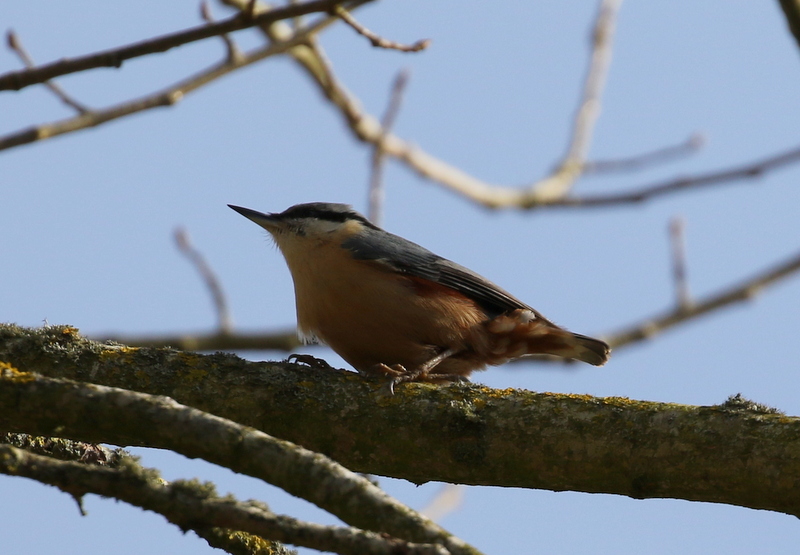 Nuthatch – defending its nest hole from the local Blue Tits
Nuthatch – defending its nest hole from the local Blue Tits
We really wanted to see the Lesser Spotted Woodpeckers today, and we were encouraged by the news that they had been seen much earlier this morning. After several days where they have been more elusive, this sounded promising. While we waited, we managed to get a Lesser Redpoll in the scope, a male with pink wash over its breast. We could hear loads more Redpolls chattering in the sallows. A pair of Mandarin flew in from the trees calling and headed upstream along the river. A pair of Grey Wagtails flew in to one of the trees which had fallen across the river.
Walking up a bit further, we stopped to listen again. Then we heard a Lesser Spotted Woodpecker calling, distantly at first. It called a second time, seemingly a bit closer. Then one appeared in a dead tree a short way back along the path. We quickly got it in the scope and could see that it was the male Lesser Spotted Woodpecker, with a bright red crown when it caught the sunlight. It set off on a quick circuit around the block of poplars, calling occasionally, never staying at the same tree for long. It was a job to follow it.
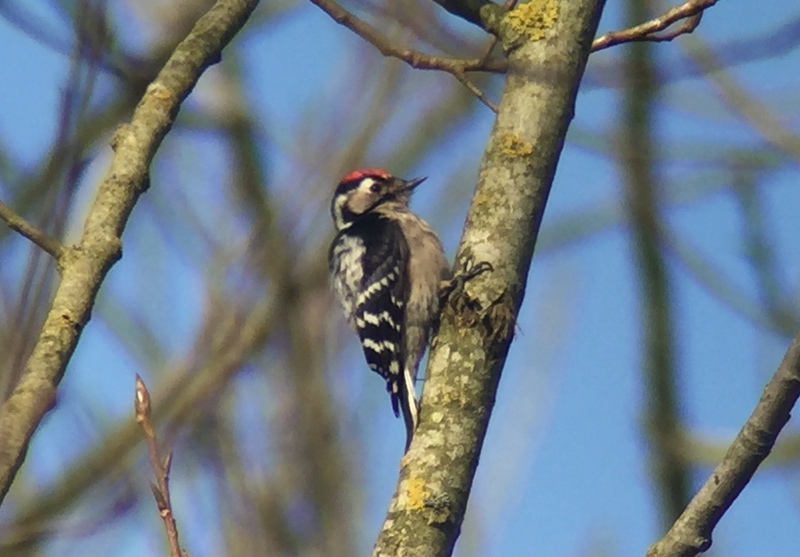 Lesser Spotted Woodpecker – the male, with bright red crown
Lesser Spotted Woodpecker – the male, with bright red crown
The Lesser Spotted Woodpecker made its way further back into the trees and disappeared from view. We thought that might be it, but then it called again, closer to us once more. It worked its way quickly back to the dead tree where we had first seen it and the next thing we knew it was excavating a nest hole! The entrance was round towards the back of the tree, out of view, but we could see the male lean in, and when it came back out a shower of wood shavings fell to the ground. It carried on excavating for at least 15 minutes, in view all the time.
Even better, when the male Lesser Spotted Woodpecker finally paused in its excavations and started calling again, a second bird answered it from deep in the trees away to the left. The two called to each other again, and we could hear the second woodpecker was coming closer. Then it appeared in a tree nearby, the female, with a black crown. After a few seconds she flew to the tree where the male Lesser Spotted Woodpecker had been excavating, hopped up the trunk nearby, and then flew over and ousted the male from where he had been working. He flew off and she started to inspect the hole. It didn’t look like she was too impressed because, after a minute or so, she flew off to, disappearing back into the trees behind.
We had been watching the Lesser Spotted Woodpeckers for over 45 minutes, a real treat with such an elusive and fast declining species. And to see both male and female, at one point together on the tree. Wow – great stuff! We made our way back to the car park, stopping on the way to admire various butterflies out in the spring sunshine – Red Admiral, Small Tortoiseshell, Peacock, Comma and Brimstone. We also had a quick look in on the Honey Bee nest in a tree by the path.
It seemed like a good time to go looking for Goshawks next. We made our way to a convenient spot overlooking the Forest and set ourselves up to scan. Despite the warmer conditions today, there was still a cool NE breeze, though it was not as blustery as yesterday. Raptor activity still seemed a little slow this morning. A couple of Sparrowhawks circled up. There was no shortage of Common Buzzards in view, but they were not gaining any great height above the trees. Two of the Buzzards drifted over towards where we were standing and one of them was promptly dive bombed by a Kestrel. Eventually we located our first Goshawk of the morning, but it was very distant.
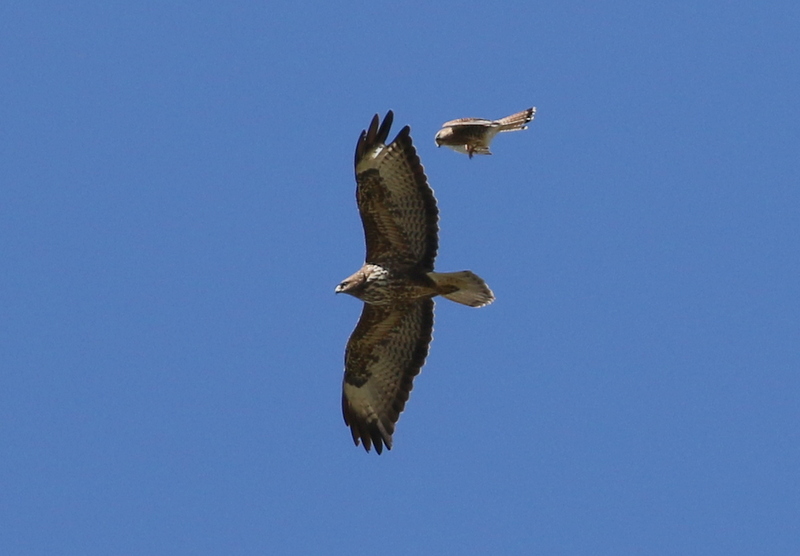 Common Buzzard and Kestrel – the latter mobbing the former
Common Buzzard and Kestrel – the latter mobbing the former
A scan of the stoney field behind eventually produced a Stone Curlew. It was hard to see at first, sitting down in the field in a dip. However, it finally stood up and gave itself away. We could see its staring yellow iris and dark-tipped yellow bill. Then it sat down and merged back in with the stone and clods of earth, perfectly camouflaged.
With Goshawk activity seemingly still subdued, we decided to go off to look for the Great Grey Shrike next and come back and have another look here later. So we drove round and parked up next to the ride. The clearings here have been very good for Woodlark recently, but there was no sound of any as we walked down the track. The females are probably on eggs now. It was also warm today and the middle of the day by now, which is when they are least active. We could hear the snap, crackle and pop of the pine cones opening in the spring sunshine as we walked down beside a mature plantation.
Thankfully, the Great Grey Shrike was much more obliging. As soon as we walked round the corner, we saw it, its white and silvery grey plumage really standing out against the deep green of a young pine plantation. It was perched right on the top of a young tree. There was quite a bit of heat haze now, so we walked round to where we could get a close look without disturbing it. Through the scope, we could see the pointed tip to its bill.
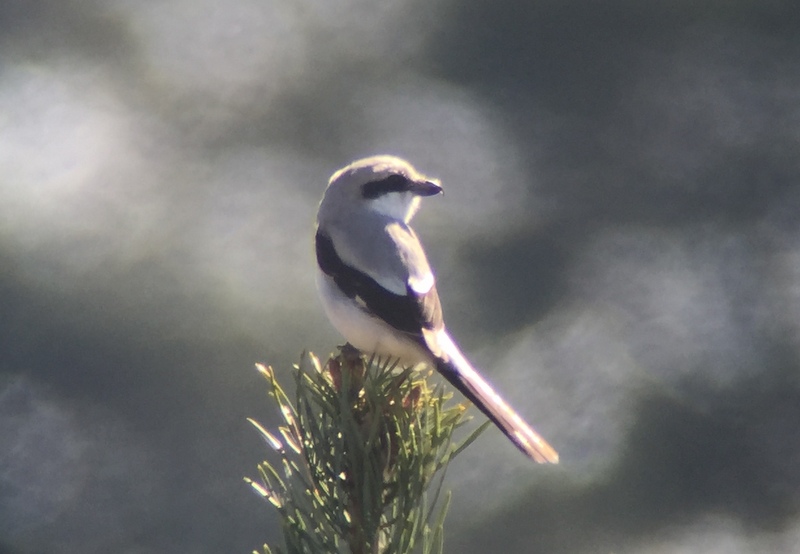 Great Grey Shrike – showing well around the same plantation again today
Great Grey Shrike – showing well around the same plantation again today
There were more raptors coming up now, over the trees beyond. Three Red Kites circled up with four Common Buzzards. We figured there had to be a Goshawk here too and, sure enough, a large juvenile female Goshawk then circled up out of the trees. It gained height rapidly, climbing with the Buzzards for a bit, before it drifted away from them. A second Goshawk appeared nearby, an adult, probably a male, and engaged in a quick burst of display, possibly trying to get the juvenile Goshawk out of its territory. Then we lots track of both of them high in the sky.
As we walked back towards the car, we made a quick circuit of the clearings looking for Woodlark. We were almost back to the car when we found two, which flew up from the ground and proceeded to chase each other all over the place. One of the two Woodlarks then started to sing, fluttering over the clearing, sounding distinctly mournful, before suddenly stooping straight down to the ground where it disappeared completely among the tussocks and clods of earth. A pair of Mistle Thrushes dropped down to feed out in the clearing too, though given their size they were a bit easier to see on the ground.
It was lunchtime now, but we decided to head back to the vantage point overlooking the Forest and eat our lunch scanning for Goshawks. As soon as we got out of the car, we spotted one. It was another juvenile, flying in and out through the tops of the trees. It gave a quick burst of display, with deep and exaggerated wingbeats, then disappeared behind the trees. After a few seconds, it reappeared further over, circled up rapidly and drifted away from us over the Forest.
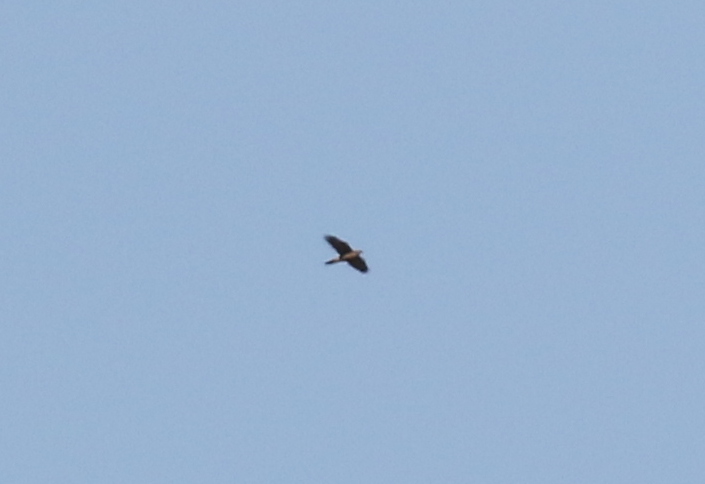 Goshawk – this juvenile circled up over lunchtime
Goshawk – this juvenile circled up over lunchtime
After we had eaten lunch, we packed up and headed over to Lynford Arboretum for the rest of the afternoon. As we walked up along the path, we could see quite a crowd gathered by the gate. Thankfully, that was because the Hawfinches had been showing well and it wasn’t long before we were watching our first Hawfinch of the day feeding down in the leaf litter.
 Hawfinch – feeding down in the leaf little from the gate
Hawfinch – feeding down in the leaf little from the gate
Over the next half an hour or so, there was a steady coming and going of Hawfinches. There were several birds, though it was hard to know exactly how many in total, but we did have three in view at once at one point, a female and two brighter males. It was great to see them so well – they are big finches, particularly compared to the Chaffinches and Bramblings nearby, with an enormous and powerful steely grey bill.
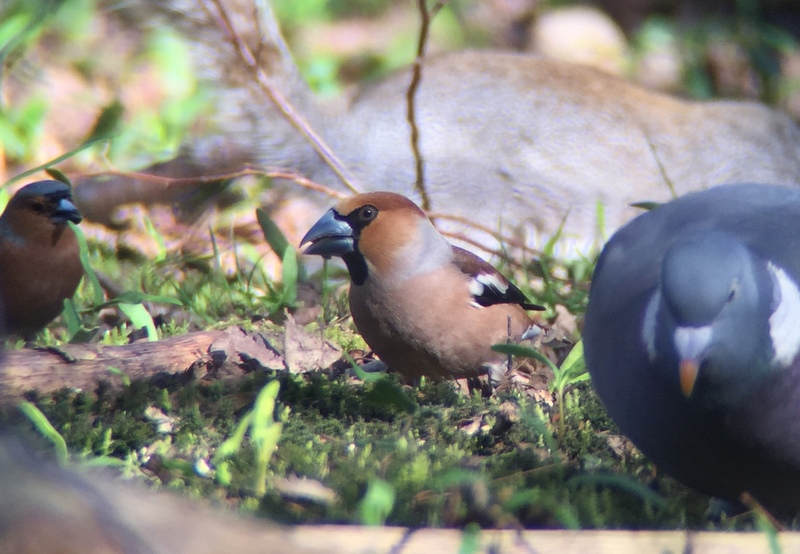
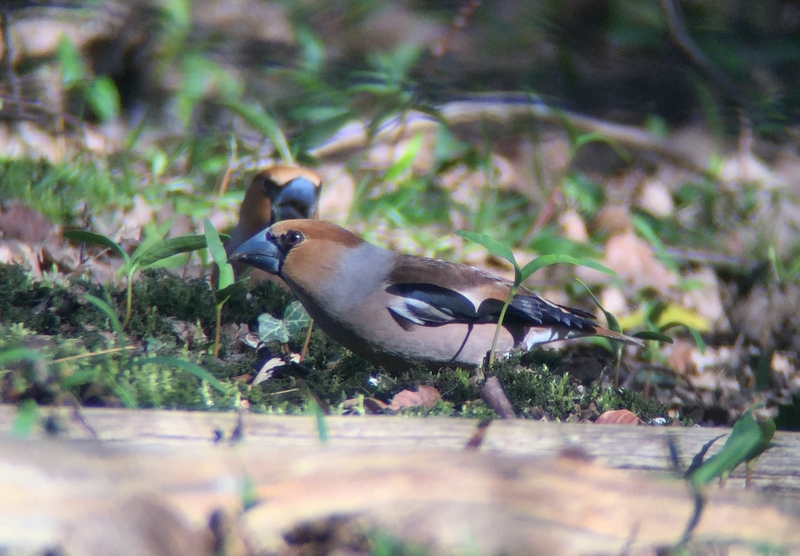 Hawfinches – there were at least three coming down to feed today
Hawfinches – there were at least three coming down to feed today
There were lots of other birds coming down to feed and drink from the gate this afternoon. As well as the Bramblings, a mixture of duller females and brighter orange breasted males, we saw Siskins, Nuthatches and a selection of tits. A Redwing was lurking in the leaf litter at the back for a bit, later replaced by a Song Thrush. A Great Spotted Woodpecker landed on the ground and started feeding too, at one point.
 Great Spotted Woodpecker – feeding on the ground from the gate
Great Spotted Woodpecker – feeding on the ground from the gate
Eventually we decided to tear ourselves away from all the action at the gate and walk down towards the bridge. The pine trees at the top of the hill were rather quiet today, as we passed. A Goldcrest sang from the firs on the way down.
Down at the bridge, there was quite a bit of food spread out for the birds and quite a bit of activity as a consequence. A couple of Nuthatches came in and out several times, as did the local Marsh Tits and a pair of Reed Buntings. A Treecreeper was busy climbing up the various alder trunks. A sharp-eyed member of the group spotted a Water Rail down in the sedges below the bridge.
We were hoping to see Common Crossbills here and we didn’t have to wait too long to be rewarded. At first a juvenile flew in and landed in the top of the poplars above us. Then a red male Crossbill and a grey green female flew in too. They flew around in the alders by the bridge for a bit, perching up from time to time where we could see them. We had a good look in the scope, getting a close up view of their distinctive crossed mandibles.
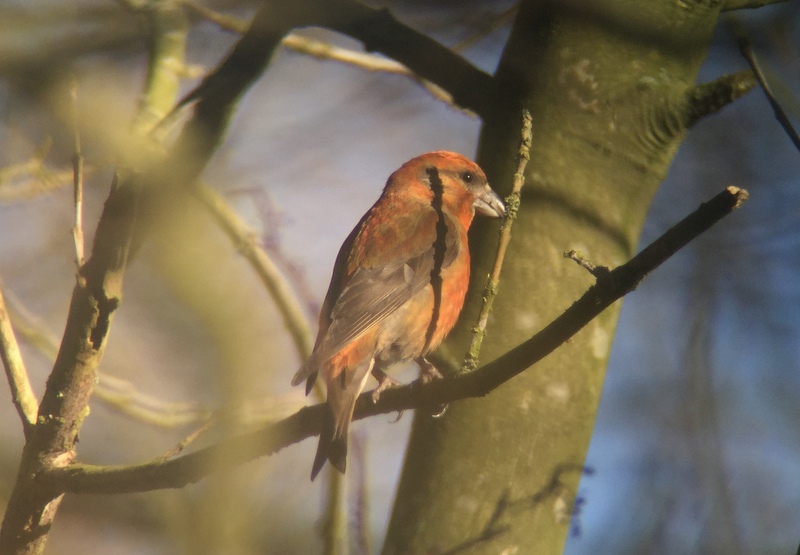 Common Crossbill – a bright red male
Common Crossbill – a bright red male
When the Crossbills disappeared back into the trees, we decided to move on. We walked round to take a look at the Long-tailed Tits’ nest – we could just see one of the adult birds sitting curled up tight inside. Then we took a walk round the lake. It was nice and quiet at first, but then a large and very noisy extended family group out for an afternoon stroll came the other way. There had been a nice selection of birds on the lake – Gadwall, Mallard and their domesticated brethren of various forms, Tufted Ducks, Canada Geese and a couple of Little Grebes. But when one of the youths in the group kicked a rugby ball out into the middle of the water, most of the ducks flew off.
We carried on round to the far end of the lake, but it was fairly lifeless here after all the disturbance. On our way back, we could see two youths climbing through the bushes on the far side of the lake in an attempt to get their ball back. A pair of Mandarin flew round calling, presumably having just been flushed. They landed again back near the bridge and we just got a look at them before they swam into the reeds. As we walked back over the bridge, a smart male Siskin flew down right in front of us, perched on a low branch twittering, and then nearly landed at our feet before thinking better of it.
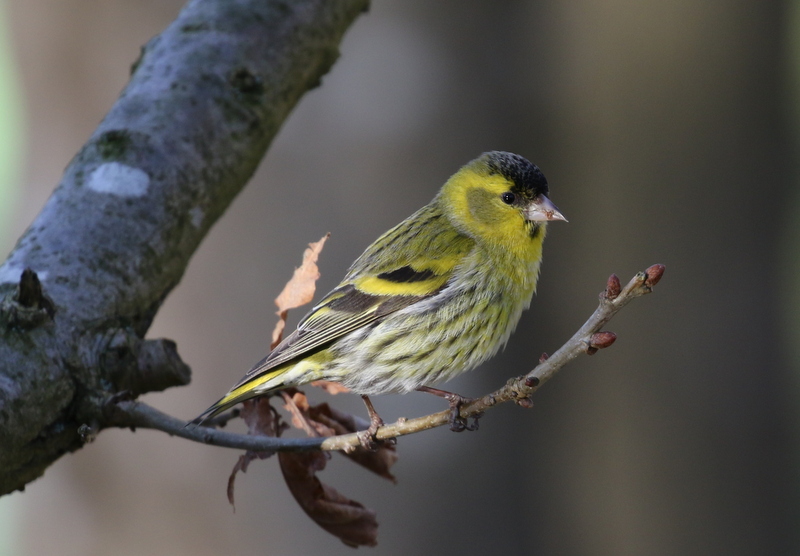 Siskin – this male almost landed at our feet
Siskin – this male almost landed at our feet
There was still time for once last bonus. As we got back to the car park, we could hear a Firecrest calling. We couldn’t work out where the sound was coming from at first, but then it flew up out of a low fir tree right in front of us. We had a great look at its black and white striped face, before it flicked up higher in a bare beech tree. A lovely way to end a very successful day in the Brecks.
















